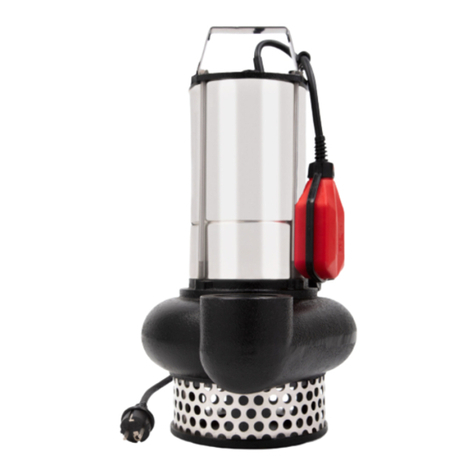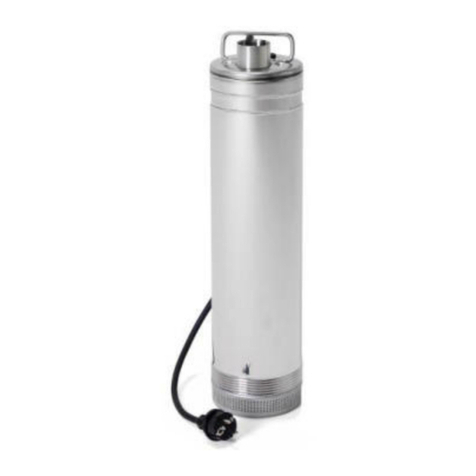
FRANÇAIS
autres essais d’allumage avec des intervalles regulièrs de 15min pendant la première heure de
fonctionnement. En cas d’absence d’eau pendant cette periode, les essias seront faits chaque
heure pour les prochaines 48 heuers. Par la suite, il sera nécessaire de réactiver le circuit
manuellement (débranchez et re-insérez l’alimentation électrique).
3.2.2 L’électropompe peut reconnaitre si le clapet anti retour s’enraye à cause du calcaire et
incrustations ou sable. Si le clapet result enrayé, l’électronique de control envoie la pompe en
bloc. Il sera possible de faire repartir la pompe seulement après avoir enlevé les causes de
l’obstruction et en activant le circuit manuellement (débranchez et re-insérez l’alimentation
électrique).
Voir ANNEX “C”.
Voir ANNEX “B”.
Fiche non correctement insérée
Vérifiez l’électricité dans la prise et
branchez la fiche électrique
Interrupteur différentiel est intervenu
Libérez la roue de possible obstructions
Moteur ou condensateur endommagé
Clapet anti retour bloquée
Retirer les causes de l’obstruction,
débranchez et re-insérez l’alimentation
Rétablir le niveau de l’eau
La requis de l’hauteur est supérieur aux
Consulter et respecter les caractéristi-
caractéristiques de la pompe
L’hauteur géométrique de la position de
Vérifiez la conformité de l’hauter géomé-
la pompe au poit de l’installation est
trique maximale rapport sur le schéma
Nettoyez la grille et/ou le filtre
Tuyau partiellement obstrué
Contactez le revendeur pour le
Sens de rotation incorrect
Vérifiez et éventuellement inversez
(seulement pour la version triphasée)
Interrupteur d’alimentation défectueux
Pas installé un vase ou pot d’expansion
Installer un vase ou pot d’expansion
Est présent un utilisateur ouverte
Assurez-vous que tous le utilisateurs sont
Solides empêchent la libre rotation de la
Température du liquide ou densité trop
Vérifiez l’ètat du liquide à pomper
Contactez le revendeur pour le
Absorbtion du moteur trop élevée
Vérifiez les causes qui conduisent
le moteur à faire un effort trop élevé avec
L’électropompe est bloquée
Controlez les frottements entre parties
mobiles et parties fixes.
Contrȏlez l’ètat d’usure des
4. DÉCLARATION DE CONFORMITÉ
5. DOCUMENTATION TECHNIQUE
6. IDENTIFICATION DES INCONVÉNIENTS ET REMÉDES
Verificare le connessioni
Verificare la presenza di elettricità
Interruttore differenziale intervenuto
Liberare la girante dalle possibili
Motore o condensatore danneggiato
Valvola di ritegno interna bloccata
Rimuovere l'ostruzione, disinserire e
reinserire l'alimentazione
Ripristinare il livello dell'acqua
La prevalenza richiesta è superiore
Consultare e rispettare le caratteri-
alle caratteristiche della pompa
L'altezza geometrica tra il punto di
Verificare il rispetto dell'altezza geo-
richiesta dell'acqua e il punto di in-
metrica massima riportato sullo
stallazione della pompe è eccessiva
Griglia aspirazione e/o filtro ostruiti
Pulire griglia e/o filtro
Tubazione di mandata parzialmente
Rimuovere le eventuali ostruzioni
Contattare assistenza per la sostitu-
Il senso di rotazione non è corretto
Verificare che il senso di rotazione
(nelle sole versioni trifase)
sia rispettato ed eventualmente
L'interruttore di alimentazione è
Sostituire l'interruttore a monte
Non è stato installato il vaso di
Installare vaso di espansione
espansione sul circuito di mandata
E' stata lasciata una utenza aperta o
Verificare che tutte le utenze siano
è presente una perdita nell'impianto
chiuse e non ci siano perdite
Corpi solidi impediscono la libera
Rimuovere le eventuali ostruzioni
Temperatura del liquido da pompare
Verificarele condizioni del liquido
Contattare assistenza per la sostitu-
L'assorbimento del motore è troppo
Varificare le eventuali cause che
portano il motore ad un eccessivo
sforzo e conseguente surriscalda-
L'elettropompa è bloccata meccani-
Controllare il verificarsi di striscia-
mento tra parti mobili e fisse, con-
trollare lo stato di usura dei cusci-































